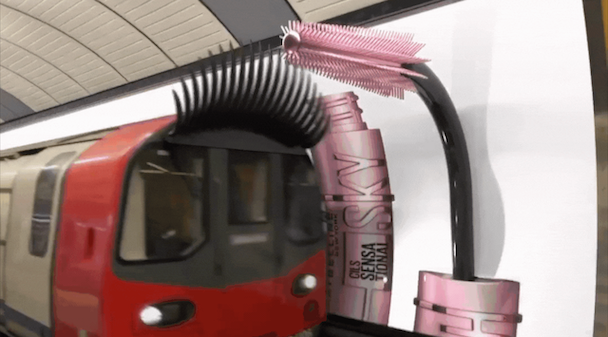How is the outdoor advertising industry responding to ‘faux-out-of-home’?
For The Drum’s latest Deep Dive, The Media Convergence, we explore what happens when social media meets out-of-home, and when brand experiences that never actually happened in the real world are presented as if they did.

Maybelline New York put out a video showing giant eyelashes fixed to an underground train
Billboards – as we know them – have been around since the 1830s. The basic concept of outdoor advertising has arguably been around for millennia; graffiti detailing the results of gladiatorial matches has survived from ancient Rome, and the ancient Egyptians would display laws to the public on huge monoliths.
Recently, an altogether new form of out-of-home (OOH) has been doing the rounds. It's called faux-out-of-home, or FOOH, and as its name suggests, it's essentially any advertising that masquerades as authentic OOH.
A recent example is a campaign from UK-based fitness company Gymbox, which released a photo of an ad for its aerial classes running on the roof of a London bus. It was later revealed that the company had never placed any ads on the top of any buses; the image had been taken from a stock picture website.
Advertisement
Gymbox’s marketing director Rory McEntry, when explaining why the brand chose this route, says: “OOH is a huge expense for smaller brands and you can drive similar or more reach through digital executions for a fraction of the price, so it makes sense for a lot of brands to explore FOOH. Our brand and budgets aren’t anywhere as big as the big brands ... so we have to work harder and find clever ways to get our message out there.”
A more memorable – and more elaborate – example of FOOH came in July when American cosmetics company Maybelline New York put out a video showing giant eyelashes fixed to the front of a London bus and an underground train, passing through giant mascara brushes protruding from its billboards. The video was quickly revealed to be computer-generated.
@maybelline All aboard the Sky High Mascara Express ✨ After hitting the NYC Streets, we’re taking over London We are on the move with #SkyHighMascara elevating your lash game to new heights ️ it’s guaranteed to serve limitless lash length and full volume #Maybelline ♬ original sound - Maybelline New York
Also in July, a United Arab Emirates-based ad agency called Eye Studio posted a video to its Instagram page displaying what appeared to be an enormous 3D Barbie doll stepping out of a box next to the Burj Khalifa, the world’s tallest building, in Dubai.
According to Reuters, the agency later confirmed that the installation, launched to promote the recently released Barbie movie, was in fact a computer-generated video.
“If the amount of inquiries we’ve received [following the release of the video] is anything to go by, we definitely think that this is going to be the next [big] thing in the marketing industry,” says Juhi Rupani, creative director at Eye Studio.
Where does all of this leave the traditional OOH industry? As technology evolves, enabling simulations of OOH that are cheaper, faster and perhaps more attention-grabbing than the real thing, could the latter gradually go out of style?
Advertisement
When asked about this apparent new wave of FOOH, experts are quick to point out that this phenomenon has in fact been around for quite a while. David McEvoy, chief marketing officer at OOH marketing brand JCDecaux, points out that “even before digital [ads], you’d often see television ads featuring billboards, street furniture or bus shelter panels … the creative didn’t actually exist in the out-of-home world.” OOH brands have also long tapped into what’s essentially FOOH when they’re pitching a mock-up to clients by, say, creating a digital version of what would eventually become a real billboard.
FOOH has long existed in parallel to OOH, McEvoy says, “because people want to hijack the benefits of being out-of-home and what those can do for their brand.” And what are those benefits, exactly? “There’s something about being seen in public which confers trust,” he says. “There’s a level of trust behind brands that are advertising in the real world because if you’re going to put yourself out there, you should be a brand with a strong brand reputation … being in public conveys that which you don’t get in a private moment on the small screen.”
While a viral FOOH campaign might temporarily boost a brand’s visibility among a younger, social media-savvy audience, some would argue that it could ultimately damage that brand’s reputation. “If I think about a handful of these faux campaigns, if I were to see it on, you know, Instagram or Reels or TikTok, I may go check it out … I would immediately have gone to the London Underground and been like, ‘I want to see this, I want to experience it,‘” says Ian Dallimore, vice-president of digital growth and general manager of programmatic at Lamar Advertising. “That’s the biggest thing about out-of-home: It’s about being in the physical environment and experiencing it.”
A kind of synergistic union exists between OOH and social media, in Dallimore’s view. “More and more, photos are being taken by real humans that are interacting with and experiencing these [OOH campaigns], posting them on social and being a part of the experience.” He argues that FOOH, by skirting the opportunity for real interaction between a physical ad and bypassers, is unable to tap into the real potential of OOH: “Skipping that actual environmental impact and that moment in time from a human element … people see through it fairly quickly.”
Suggested newsletters for you
JCDecaux’s McEvoy shares the belief that digital simulations of OOH campaigns are unable to match the benefits that their actual, physical counterparts have to offer. “The best out-of-home campaigns are the ones that run with great creative work at scale, [which] creates a national presence – that’s the strength of out-of-home,” he says. “When you translate that into trying to show it in other media, I just don’t think it has the same strength, it doesn’t have the same impact as actually doing it for real or doing it properly.”
Dallimore is particularly wary about uses of FOOH that, like the recent campaigns from Gymbox and Maybelline New York, are centered on public transportation. Companies like Lamar, he says, will often enter into “very tight” contracts with transit authorities like the MTA in New York City or the London Underground. “There are a lot of rules and regulations that go around [these contracts],” he says, including the fact that certain kinds of marketing – political campaign ads, for example – are not allowed in some airports. OOH vendors that partner with transit agencies are also “liable for any type of creative that goes live” within the latter’s property. Dallimore imagines that a concerned employee from the London Underground must’ve made a call to the organization’s OOH vendor, asking: ”‘Did this actually go up? Because that’s a huge safety issue.’”
FOOH campaigns that use images of subways, buses or other modes of public transportation, Dallimore says, “creates a bit of confusion and could also jeopardize these contracts that we, the publishers, have with transit authorities, airport authorities, etc. So that’s a big issue.”
Lina Maggi, vice-president of partnerships and head of OOH at BCN Visuals, adds that for most marketers, it would have quickly been “very, very apparent” that the Maybelline New York campaign wasn’t actually built into the London Underground. “It’s not just a free-for-all, do-whatever-you-want situation in the out-of-home space – there’s still a lot of regulation.”
Despite McEvoy’s and Dallimore’s misgivings about OOH (which are understandable, given their roles), the medium comes with some notable benefits. For one thing, it’s much less expensive than paying for an actual OOH campaign; depending on the location, traditional billboards can cost anywhere between several hundred dollars and many thousands of dollars a month. According to digital and OOH agency Dash Two, a billboard in Los Angeles’ illustrious and heavily trafficked Sunset Strip can cost as much as $55,000 a month. Maggi gives a much higher estimate for that prime location: up to as much as $200,000 a month.
FOOH also allows brands to simulate marketing efforts that, if they were to be actually built, would clash with municipal safety codes (as in the case of the Maybelline New York campaign) or basic physics (as in the case of the giant Barbie). In this sense, the appeal of FOOH is analogous to that of the metaverse, that burgeoning virtual world that until recently captivated the attention of so many brands. The laws of man and nature need not stand in your way when you’re building in a virtual environment.
Then, of course, there’s the virality element, the fact that FOOH, largely as a function of the fact that it initially seems to be real, is attention-grabbing and likely to receive a healthy amount of attention on social media – at least for a little while.
In light of these potential costs and benefits, brands that launch FOOH campaigns are, in McEvoy’s view, taking “a calculated risk,” comparing “the level of mass awareness you can get against [the number of] people who may take offense at it.”
Dallimore, for his part, believes that the math of FOOH does not work out in anyone’s favor: “It just creates mass confusion all the way up and down, from the vendor side to the agency side to the brand side – all for a couple of million likes.”
